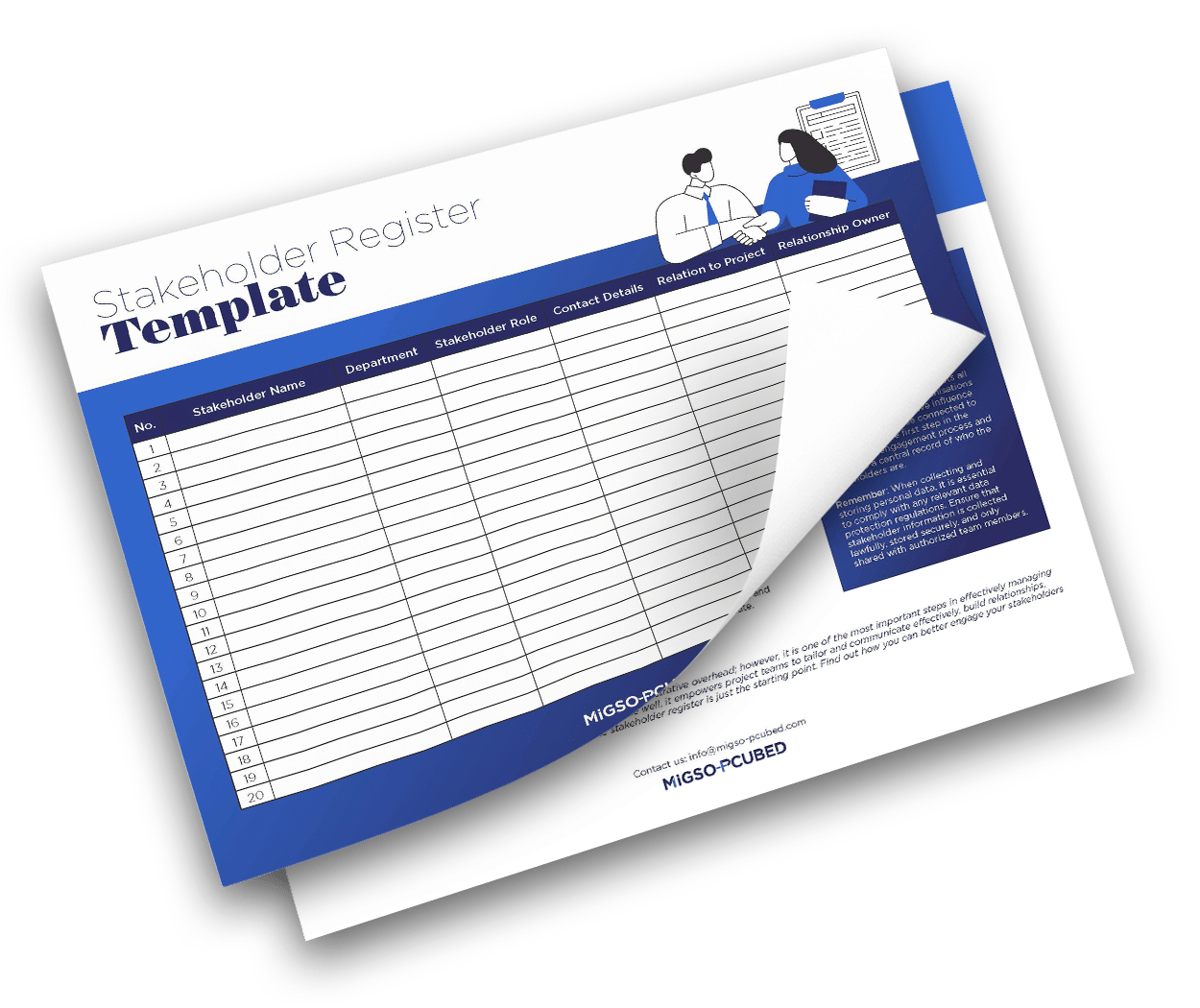- MP
- Blog
- Stakeholder Management
- Stakeholder Register: The First Step in Effective Stakeholder Management
Successful project delivery and transformational change don't happen in isolation. They rely heavily on the people who influence, support, or are impacted by your work. This is where stakeholder engagement becomes pivotal. Research consistently shows that effective stakeholder management is one of the top drivers of project success. In fact, poorly managed stakeholders are often cited as a leading cause of project delays, budget overruns, and failed implementations.
By identifying who your stakeholders are, understanding their influence, needs, and concerns, and actively enlisting their support, you lay the groundwork for lasting momentum - not just to initiate change, but to sustain it. Creating a stakeholder register is one of the first critical steps in this process. It ensures you're equipped from the outset with a clear picture of who is involved in your project and in what ways, allowing you to develop a targeted engagement strategy that overcomes resistance, fosters alignment, and maximizes the overall value delivered.
Who is a Stakeholder?
Before we dive into the mechanics of stakeholder registers, let’s first define a stakeholder. The Prosci® definition of a stakeholder is:
"Any individual or group who has a vested interest in the outcome of a change."
Prosci® emphasises that stakeholders include anyone who can influence or be impacted by the change initiative, whether they are internal team members, executives, customers, external partners, or end users. Understanding the broad stakeholder landscape is vital, it forms the basis for effective stakeholder management.
What is a Stakeholder Register?
A stakeholder register is a foundational document that lists all individuals, groups, or organisations who are affected by, have influence over, or are otherwise connected to a project. It is the first step in the stakeholder engagement process and serves as a central record of who the stakeholders are.
At this stage, the stakeholder register is primarily descriptive. Its purpose is to capture who is involved. It is not yet focused on interpreting the level of interest, influence, impact, or support. That work comes next, during stakeholder analysis , where each stakeholder is assessed based on criteria such as their power, interest, attitudes toward the project, which enables you to tailor the communication approach needed.
Why is a Stakeholder Register Important?
Although basic, the stakeholder register is essential. It ensures project teams are starting from a clear, shared understanding of all the people and groups they need to consider. From there, teams can move on to more strategic decisions about how to engage and manage each stakeholder or stakeholder group effectively.
The register should be kept up to date as the project evolves because stakeholders may change roles, new ones may emerge, or relationships may shift. Keeping the register current helps ensure the analysis and engagement strategies remain relevant throughout the project lifecycle.
How to Create a Stakeholder Register: a Step-by-Step Approach

Step 1: Identify Stakeholders
Start by identifying all potential stakeholders. This is a broad discovery phase where the aim is to capture as many relevant stakeholders as possible before filtering or analysing further. Common approaches include:
- Stakeholder Identification Workshops: Bring together key members of the project team, business leads, and subject matter experts for a focused session. Use prompts like “Who will be impacted?” or “Who has a say in this?” to guide the discussion.
- Rapid Listing Sessions: Use time-boxed brainstorming (e.g., 15 minutes) to list every stakeholder that comes to mind without worrying about relevance or priority yet. This can be a solo or group activity.
- Group Mind Mapping: Visual tools like mind maps help explore different stakeholder categories (e.g., internal, external) and reveal connections or overlooked roles.
- One-on-One Conversations: Talk with project sponsors, department heads, and others close to the work. These informal discussions often uncover stakeholders not immediately obvious from formal documents.
- Reference Project Artefacts: Review business cases, governance models, previous stakeholder registers, and project charters. These often list key names and roles already identified in earlier stages.
Aim to capture stakeholders from across functions, levels of seniority, and stakeholder types, including supporters, critics, influencers, and everyone in between.
Step 2: Capture Basic Information
Once stakeholders are identified, document their core details. This information should be structured yet simple, capturing details such as:
- Name
- Role or job title
- Department or organisation
- Contact details (email, phone)
- Relationship to the project
- Notes on how they were identified or their known involvement
This step is about documenting who they are and where they sit in relation to the project- without yet interpreting their level of influence or engagement needs.
Important:
When collecting and storing personal data, such as contact details, it is essential to comply with GDPR and other relevant data protection regulations. Ensure that stakeholder information is collected lawfully, stored securely, and only shared with authorized team members.
Step 3: Organise and Format the Register
Choose a format that suits your project team and is easy to maintain. Common formats include:
- A structured spreadsheet (e.g., Excel, Google Sheets)
- A central collaboration document (e.g., SharePoint, Confluence)
- A stakeholder management module in project management software
If you’re using a downloadable template, ensure it’s customised to fit your project structure and terminology. We suggest using consistent naming conventions and structure so that stakeholders can be easily grouped during stakeholder analysis.
Step 4: Review and Validate
Share your initial register with key stakeholders such as sponsors, senior users, or functional leads. Ask:
- Have we missed anyone?
- Are the roles and relationships accurate?
- Are there emerging stakeholders we should monitor?
This collaborative review helps validate completeness and surfaces stakeholders who may have been overlooked, before you move into deeper planning.
Step 5: Maintain as a Living Document
As the project progresses, stakeholders may change roles, new players may emerge, and relationships may shift. Build in regular review points, such as milestone completions or governance reviews, to keep the register up to date.
Tip:
Assign clear ownership for maintaining the stakeholder register throughout the project to ensure it remains a reliable reference tool.
By following these steps, you create a stakeholder register that is comprehensive, structured, and ready for the next stage: stakeholder analysis. This process of identification is not just administrative—it’s strategic groundwork that allows you to build tailored engagement plans, reduce resistance, and increase your project's chance of success.
MP’s Approach to Stakeholder Management
At MIGSO-PCUBED (MP), the stakeholder register is just the starting point. Our broader stakeholder engagement approach ensures stakeholders are actively and effectively managed throughout the project. It’s built around five core principles:
- Early Identification
We identify and map stakeholders from the outset, using tools like RACI charts and personas to ensure full coverage. - Tailored Engagement
We design engagement strategies that align with each project’s goals, culture, and communication needs. - Change Integration
Stakeholder engagement is a fundamental part of our change management approach. We identify early adopters and potential resistors early on, aligning engagement activities with the overall change strategy to build alignment, reduce resistance, and support successful adoption. - Practical Tools
We provide flexible stakeholder register templates to simplify setup and support consistent stakeholder tracking. - Ongoing Governance
We embed regular reviews into project governance to ensure stakeholders are continuously managed, not just listed.
In Summary
Creating and maintaining a stakeholder register might seem like administrative overhead, but it’s one of the most important steps in effectively managing and engaging stakeholders on any project or change programme. When done well, it empowers project teams to tailor and communicate effectively, build relationships, reduce resistance, and deliver value faster.
At MP, we see stakeholder management as a critical success factor for projects. Our methodology, rooted in best practices aligned with ADKAR and Prosci methodologies has been refined through years of client experience and helps organisations not just manage change but lead it.
We’re pleased to offer you a free, easy-to-use stakeholder register template to help get you started with capturing and organizing your project stakeholders. While this template covers the essentials, please note that our full suite of stakeholder management tools is more comprehensive, designed to support deeper analysis, tailored engagement planning, and integration with broader change management processes.


